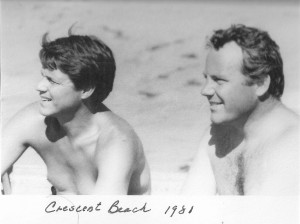
By Maziar Ghaderi, storyteller & visual communicator
John H. Goodwin had been the president of the Community Arts Council of Vancouver from 1986 to 1989, but his roots with us dig much deeper than that.
His father, Howard Goodwin, a successful Vancouver ad man was one of the five original founders of CACV in 1946. Being involved in arts and the community was a part of the Goodwin tradition since the beginning. “Public service was always inscribed in our underwear; it was just something in our upbringing,” explains Goodwin at the Architecture Institute of BC.
“After grad school, I wanted to get involved in the community once again and my mentor Geoff Andrew, one of the ‘founding five’ suggested getting involved with CACV.”
Goodwin recalls the formation of the CACV in 1946 as being very disappointing to Charleston, North Carolina, as their Council was established a year later, and thus making Vancouver’s the very first of its kind in North America. “I knew it was bad news after I visited the city and told them!” jokes Goodwin.
At that time you had the businessmen running the town and their spouses, who normally didn’t work outside the home, took on volunteering posts. But during Goodwin’s time in the late 80’s, society had changed a great deal. The city was a different place, and past CACV initiative now fully self-sufficient left the Council with idle hands. Good thing John H. Goodwin, a professional strategic planner and management consultant now took the president’s chair. “The purpose of me coming in was to refocus, because to a certain extent, the CACV had lost its way in this new Vancouver.”
As a part of fellow past president Anthony Norfolk’s crusade to save the old TD building on Seymour and Hastings [now the Wosk Centre for Dialogue], Goodwin took part in a debate with then Vancouver mayor, Gordon Campbell on the CBC. “I learned a lot about how you deal in politics and how to make five points regardless of the questions asked!”
Being a man of vision, Goodwin had a knack for politics and public policy. During the Council’s lean years, he reached out to his network and brought in a robust mix of individuals from various ethnic backgrounds, political dispositions and perspectives. When these new troops were assembled, Goodwin went around the table and asked, “why are you here?” and the one common thing they all had was a childhood connection to the arts. “Art and art education brings us together as a society; this is why CACV is so important.”
Another major “hurrah” of Goodwin’s was the revitalization of the Vancouver Symphony Orchestra, which went bankrupt in 1988. “We jumped in, took the lead and even financed a professional from the East to make an assessment that prompted Gordon Campbell to start a task force, which I was a member of. We were very proud to help the VSO get grounded again.”
Like the conscience of the city, institutions such as the Orpheum Theatre, Vancouver Opera and the Playhouse wouldn’t have the resources they needed to start up without the Council.
“I mentor executives in the hi-tech industry, who are 20, 30 years younger than me; they may be brighter than me when it comes to technology but they haven’t done much. One of the problems with education now is the focus on the how; the formula to do something and no attention is put on the why. We need leaders with the creativity to understand the why because when circumstances and surroundings change and all you’ve been giving is the ‘how training’ you’ll be totally lost. The arts gives us the opportunity to be creative and see things dynamically,” explains Goodwin.
“Early in life, it is important to have access to a creative faucet. Art is an expression.”